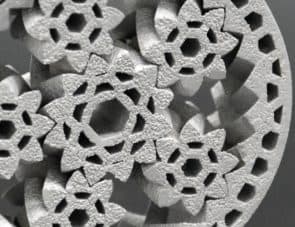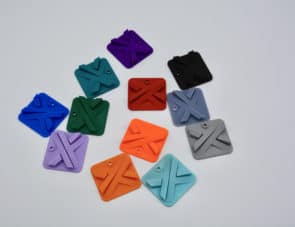The ultimate material selection guide for all 3D printing services available at Xometry: selective laser sintering (SLS), HP Multi Jet Fusion (HP MJF), fused deposition modeling (FDM), stereolithography (SLA) and Selective Laser Melting(SLM).
| Polymers | Materials |
| Rigid | ABS-M30, ABS-ESD7, ABS-SL-7820, ASA, Nylon 11, Nylon 12 Carbon-Filled, Nylon 12 Glass-Filled, PC – ABS Polycarbonate, PC-ISO, PC – Like Heat Resist Translucent, Polycarbonate, PLA, PETG, PEEK, ULTEM 1010, ULTEM 9085, Watershed XC 11122, Xtreme Grey Polypropylene, Xtreme White 200, RPU 70, FPU 50, EPX 82, DPR 10, UMA 90, CE 221 |
| Flexible | Flex Whitish TPU/TPE-like, Estane 3D TPU M95A |
| Rubber-Like | SIL 30, EPU 40 |
Rigid Plastics
ABS M30
This is a high impact resistant and tough material: it has a glass transition temperature of about 105°C. It is highly resistant to aqueous, phosphorus and hydrochloric acids. However, it can be damaged by sunlight. It is useful in the production of drain/waste pipes, inhalers, housings for electrical/electronic components and musical instruments.
3D Printing Technology: FDM
Price: $
ABS ESD7
This is a durable thermoplastic with electrostatic-dissipative properties. It is particularly suitable in applications where static charges can cause damage to products or explosions. It is widely applied in the manufacturing of jigs and fixtures for electronic components.
3D Printing Technology: FDM
Price: $
ABS SL 782
With a black appearance, this material is rigid and tough. It allows for accurate and robust build with good surface finish and detail. It has a heat deflection temperature of 51°C with tensile strength of 45MPa. It is used for automobile components, consumer packaging, electronic coverings and toys.
3D Printing Technology: SLA
Price: $$$$
ASA
This is an amorphous thermoplastic with improved weather resistance. It is widely used in prototyping in 3D printing due to its UV resistance and excellent mechanical properties. It has good resistance to chemicals and heat, with a glass transition temperature of 100°C. ASA is available in a large variety of colours.
3D Printing Technology: FDM
Price: $
Nylon PA11
This material is highly impact-resistant with a shore hardness of 80. It has a heat deflection temperature of 180°C with excellent resistance to hydrocarbons. It is 100% biocompatible with up to 70% reusability. It is used for cases and containers of consumer goods.
3D Printing Technology: MJF, SLS
Price: $
Nylon PA12
Nylon PA 12 is one of the most popular 3D printing materials. It has good mechanical properties such as toughness, tensile strength and impact strength. This material can also be flexed without fracture. It has a melting point of 178°C with low water absorption. It is broadly used for sterilized films for packaging materials in the food and pharmaceutical fields.
3D Printing Technology: SLS, MJF, FDM
Price: $$
Nylon PA12 Glass-Filled
Compared to the Nylon PA12, this has enhanced compressive strength with improved heat distortion temperature. Parts produced are consistent and durable. Its stiffness allows for the production of components for automotive, aerospace and consumer products.
3D Printing Technology: SLS, MJF
Price: $$$
Nylon 12 Carbon-Filled
The blend of Nylon 12 resin with chopped carbon fibre gives this material excellent structural properties. The carbon fibre occupies 35% of its weight. This allows for distinct freedom of design. It has wide applications in the automobile, industrial and recreational industries.
3D Printing Technology: FDM
Price: $$
PC – ABS Polycarbonate
This material offers easy modifications by the addition of glass fibre and minerals. It has good impact resistance and improved toughness compared to ABS. However, it has a low continuous service temperature. It is used in components for automotive interior and exterior, computers and electrical enclosures.
3D Printing Technology: FDM
Price: $$
PC – ISO Polycarbonate
It has a tensile strength of 57MPa with a heat deflection temperature of 133°C. It is a strong, heat resistant material. It is biocompatible resulting in its broad use in food and drug packaging.
3D Printing Technology: FDM
Price: $$
PC-Like Heat Resist Translucent (Accura 48)
This is best suited for parts that require high strength and stiffness with high-temperature resistance. It is widely used for the manufacturing of prototypes of electronic and lighting components. It provides enhanced feature details.
3D Printing Technology: SLA
Price: $$$
PC – Polycarbonate
FDM printing Polycarbonate (white)
Polycarbonate is a tough and amorphous material with high impact strength, stability and good electrical properties. It has a wider temperature range of usage with heat deflection temperature of 140°C. It is commonly used for the production of safety helmets, lenses for car headlamps and bullet-proof glasses. It is comparable to PMMA.
3D Printing Technology: FDM
Price: $$
PLA
This material is made from renewable resources including starch and sugarcane. It is completely biodegradable. It has good mechanical properties with a glass transition temperature of 55°C and a melting point of 180°C. It is used in the food and medical industry. It is also used for structural applications such as fibres and insulation.
3D Printing Technology: FDM
Price: $
PETG
This material has significant chemical resistance, durability and good formability. It has low forming temperatures making it popular in consumer applications. It is commonly used for food containers and bottles for liquid beverages. However, its soft surface makes it prone to wear.
3D Printing Technology: FDM
Price: $
PEEK
It has excellent resistance to harsh chemicals with high mechanical strength and dimensional stability. It has the ability to retain its stiffness at elevated temperatures and can be employed for continuous use at temperatures up to 170°C. It is used in aerospace, oil and gas and semiconductor production.
3D Printing Technology: FDM
Price: $
ULTEM 1010
This material has the highest heat resistance, chemical resistance and tensile strength compared to other FDM thermoplastics. It is available in transparent, opaque and glass-filled grades. It has broad application in custom tools for metal or plastic parts fabrication, medical tools and temperature resistant dies.
3D Printing Technology: FDM
Price: $
ULTEM 9085
This has a high strength-to-weight ratio, high impact strength with good heat resistance. It is highly flame retardant. It is used in the production of prototypes as well as tools such as jigs, fixtures, composite moulds etc. It is comparable to nylon 6.68 (9800).
3D Printing Technology: FDM
Price: $
Watershed XC 11122 – Transparent ABS/PBT-Like
This is a low viscous material that produces parts that are strong, tough, water-resistant and most importantly, nearly colourless. It is ideal for the production of lenses, concept models, medical and consumer electronics. It is comparable to standard ABS in mechanical and thermal properties.
3D Printing Technology: SLA
Price: $$$$
Xtreme Grey Polypropylene
This material has excellent toughness and is resistant to breakage. It has a tensile strength ranging from 38 – 44MPa with a heat deflection temperature of 62°C. It is ideal for snap fits used in enclosures for consumer and electronic products.
3D Printing Technology: SLA
Price: $$$
Xtreme White 200 Polypropylene
It has high elongation at break, high impact strength with excellent toughness. It is stiff and durable. Its glass transition temperature is 52°C. It offers a stunning white finish with clean sidewall quality. It is applied in general-purpose prototyping and snap fits.
3D Printing Technology: SLA
Price: $$$
RPU 70 (Rigid Polyurethane)
This is a stiff material with high strength. It has moderate resistance to heat with a heat deflection temperature of 60°C. It provides an excellent surface finish. It is used for housings, clips, covers, and brackets across a wide range of industries.
3D Printing Technology: Carbon DLS
Price: $$$$
FPU 50 (Flexible Polyurethane)
This resin is robust and semi-rigid. It is suitable for applications that require toughness to withstand repetitive loading. It has a tensile strength of 29MPA with a heat deflection of 78°C.
3D Printing Technology: Carbon DLS
Price: $$$$
EPX 82 (Epoxy)
This material has an excellent blend of toughness, stiffness, temperature resistance and high tensile strength of 82MPa. Its UV and thermal stability make it suitable for a wide range of applications including housings, light fixtures, jigs and more. It allows for accurate designs.
3D Printing Technology: Carbon DLS
Price: $$$$
DPR 10 (Digital Production Resin)
This material offers high accuracy and quick printability. It has a heat deflection temperature of 61°C. Its rigidity makes it suitable for models and dies.
3D Printing Technology: Carbon DLS
Price: $$$$
UMA 90 (Urethane Methacrylate)
It produces a smooth surface finish with excellent mechanical properties. It has high stiffness and strength. It is perfect for the production of prototypes. It has a tensile strength of 46MPA it has a heat deflection temperature of 51°C.
3D Printing Technology: Carbon DLS
Price: $$$$
CE 221 (Cyanate Ester)
This resin has long-term thermal stability with a glass transition temperature of about 225°C. It is useful for electronic and industrial components. It has a tensile strength of 92MPA.
3D Printing Technology: Carbon DLS
Price: $$$$
Flexible Plastics
Flex Whitish TPU/TPE–Like
This material combines rubber-like qualities with high resistance to abrasion and chemical tolerance. It bends easily and returns to its original shape without deformation. It is extremely durable. It is comparable to white ABS 3mm.
3D Printing Technology: SLS
Price: $
Estane 3D TPU M95A
It has easy and quick printability. It is semi-flexible with wear and tear resistance. Its corrosion resistance makes it suitable for applications with many industrial oils and chemicals. It elongates up to 580% at break. It is used in manufacturing projects that require both rubber and plastic properties.
3D Printing Technology: MJF
Price: $
Rubber-Like Plastics
SIL 30
This material is biocompatible as well as tear-resistant. It provides comfortable skin contact. It is used in the printing of headphones, wristbands and other wearables. It has a glass transition temperature of 10°C with a shore hardness of 35. It is comparable to commercial TPE.
3D Printing Technology: Carbon DLS
Price: $$$$
EPU 40 (Elastic polyurethane)
This type of resin is useful for ornaments and mechanical parts. It has high elastic behaviour under both tensile and compressive stress. It has a tensile strength of 10MPA and can elongate up to 310%.
3D Printing Technology: Carbon DLS
Price: $$$$
Ready with the selection of 3D printing materials? Get an instant quote for your parts!


